| Soft Centre 1 |
ADVENTURE and arcade games are becoming more complex and of a better standard all the time, so it is no surprise that a company like Imagine Software has created a mixture of the two genres with The Alchemist for the 48K Spectrum.
You take the part of the alchemist who is searching for the parts of an ancient spell scroll which, when put together, will destroy an evil wizard. Your character can move around on the ground in human form or can transform into the guise of a giant bird and take to the air. All that can be performed with the keyboard or with many types of joystick.
To reach the parts of the scroll you must move past various evil monsters, including a colourful butterfly and a sheet-like ghost, which are all animated cleverly.
At first sight the game, with its cartoon maze and wizard as the central character, may remind you of the Ultimate Atic Atac. The extra features of the game, however, compensate for the similarity and there is much more variation in the maze construction and the creatures which will be seeking your blood.
If the attraction of the game is not sufficient and you still want something different you will be startled to learn that Imagine has the dubious honour of being the first software house to produce a gold-coloured cassette and cassette box. That adds interest to the game and gives a hint of what it contains when you learn that alchemists seek to turn lead into gold.
The combination of excellent cartoon animation and depth of plot should make The Alchemist a winner. It can be obtained from Imagine Software.
| THE ALCHEMIST | Memory: 48K | Price: £5.50 | Joystick: Kempston, AGF, Sinclair, Protek, Fuller, 12L | Gilbert Factor: 7 |
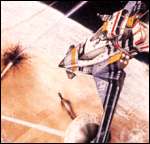
ARMAGEDDON is based on that well-known arcade game Missile Defence. It involves defending six cities from incoming waves of thermo-nuclear missiles and other airborne weapons. According to the instructions, you may have to sacrifice some civilian targets for ultimate success, although missile bases are said to be your enemy's main target.
As a game it is very fast and requires good reactions. The graphics are fairly simple but include effective mushroom clouds. There is only one level of skill and since the game is so fast-moving it would benefit from several levels.
Problems were experienced loading the game but all Silversoft games are guaranteed and can be exchanged. Overall more attention should be paid to providing a better game than having a good title page.
Armageddon can be obtained from Silversoft.
| ARMAGEDDON | Memory: 16K | Price: £5.95 | Joystick: Kempston | Gilbert Factor: 3 |
AUTOSONICS will enable you to add sound effects in Basic to your programs. Built into the program are 26 sounds to start. Twenty-one of them are named specifically while the others are under the general heading of space sounds.
All the sounds can be modified according to pitch, which can be steady or can rise and fall at a variable rate. The speed of repeat can also be varied, as can the length of the sound. Those adjustments are made on-screen using a range of graphically-displayed slider controls. Once you have created your sound the program can give you a line of Basic which will reproduce that sound exactly.
The program is clear and well-designed and is a useful addition to any amateur programmer's collection. A BEEP amplifier, as always, would be an advantage, but is by no means necessary. It shows what can be done in Basic using the limited Spectrum BEEP command and extensive instructions are provided with the cassette.
The specific sounds are not as interesting as they could be and the range of 'space noises' shows better what is possible. Overall a novel idea and well-presented.
Autosonics can be obtained from Buttercraft, Yorks.
| AUTOSONICS | Memory: 16K | Price: £4.99 | Gilbert Factor: 5 |

THE IDEA that teddy bears are cuddly has been dispelled in Bear Bovver for the 48K Spectrum. Your quest is for the batteries which will drive your car and the only way to get them is to climb the framework of ladders on the screen. There are three teddy bears just waiting to get you the moment you step out of your vehicle and a strange-looking creature with a long tail, which we have assumed to be father bear.
Before leaving the safety of your car you should plan your strategy to avoid the hairy miscreants. The only way in which you can kill the bears is to drop a battery on them or plant a bomb which should explode to good effect.
On the way up the scaffolding you can collect various bonus treats which include milk, cups of tea and Coca-Cola cans. All serve to illustrate the thought which has gone into the design of the game, which is a shining example of animated graphics.
Once you have put all three batteries of one screen into your car you can move to the next screen, which is even more complex than the previous one. The game will continue in that way until all your four lives are lost.
Bear Bovver has a brilliant new concept and without doubt will get into everybody's top ten games. It can be obtained from Artic Computing.
| BEAR BOVVER | Memory: 48K | Price: £6.95 | Joystick: Kempston, Fuller | Gilbert Factor: 8 |
AS A GENERAL rule, card games do not benefit by being translated into computer programs but Brag, for the 48K Spectrum, almost manages to compensate for the lack of real players and cash which usually make for the excitement of this classic gambling game.
Both the cassette insert and the program give clear, easy-to-follow instructions on the rules of the game for those who have never played it previously. When play starts, the screen display is carefully thought out and the action is fast - almost too fast to follow in the case of the demonstration game the computer will play for you.
The program simulates the game very faithfully, not just by reproducing the rules, but by incorporating a bluffing element, and even varying styles of play for each of the three players which it represents. The computer will even adapt its style of play to yours if you attempt to bluff too often and, when you pay to see the other players' hands, it will show you thoughtfully not just the cards but who won and the state of everyone's winnings.
The author claims that the program is almost impossible to beat and has certainly made the attempt as addictive as possible. Even if you do not enjoy swapping bluffs with a computer the program should help to prepare you for any encounters with real-life Brag players.
Brag is available from T Lebon, Essex.
| BRAG | Memory: 48K | Price: £4.95 | Gilbert Factor: 7 |
CASSETTE A from Orwin Software is a collection of 11 short programs written largely in Basic and including arcade-style and mind games. It is an enterprising collection with some very good ideas, although many of the games suffer from the inevitable slowness of Basic programming. It is possible, however, to look at the listings and some of the programming techniques are interesting.
Among the more worthwhile programs are Ghost Gobbler, a Pac-man-style game with a choice of six skill levels; Reversi, a version of the well-known board game which plays a remarkably good game; Phoebus, a colourful tile-sliding game; Black Spot, an updated version of the old favourite, Snake; Minefield, where you must drive a tank around a minefield, picking up crowns and avoiding the electrified fence.
There is also a graphics demonstration program with good, inventive use of colours and shapes. On the whole it is reasonable value but is chiefly of interest to beginners rather than arcade game freaks.
| CASSETTE A | Memory: 16K | Price: £6 | Gilbert Factor: 5 |
CAVERN FIGHTER, for the 16K Spectrum, is a version of the popular arcade game, Scramble, which is set in the unlikely location of Watford.
Your mission is to fly your spacecraft through a cavern filled with enemy fighters. You must destroy the aliens with your laser gun and hit the fuel tanks with your bombs. Points are scored for hitting aliens, or missiles, and extra fuel is allocated for hitting dumps. If you forget about the fuel dumps you will run out of fuel and crash.
Another way of crashing is to hit the ceiling or floor of the cavern as you go through it. That is all too easily done. The caverns become progressively more difficult as you advance and when you have finished with the missiles of the first phase the aliens, which look like space invaders, get bigger and meaner.
Cavern Fighter is by no means the best version of the scramble-type game on the market. It bears too much resemblance to other games, such as the Melbourne House Penetrator, to be original in either concept or graphics. The screen display is dull and little imagination has been used with the effects which could have been created in the scenario.
Cavern Fighter is available from Bug-Byte and can be obtained from W H Smith and John Menzies retail outlets.
| CAVERN FIGHTER | Memory: 16K or 48K | Price: £5.95 | Joystick: Kempston | Gilbert Factor: 4 |
THERE ARE many programs for the 48K Spectrum which will play chess with a human player but very few which will teach the game of chess. Chess Tutor One compensates for that shortcoming in the computer market and serves as an excellent introduction to the mind game.
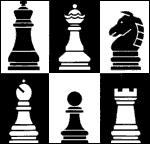
The program comprises several segments which can be loaded from a main menu. The segments introduce all the information you are likely to need when starting to play the game and it is split up in such a way as to be easy to understand. It also takes into account the level of play which you can obtain and could even be helpful to the experienced player.
Both the pieces and the tactics are explained and you have only to pick those parts of the course you need. For the beginner it may mean looking at the parts relating to all the pieces, whereas the experienced player will want to learn about tactics, such as skewers, pins and forks.
All the lessons are punctuated with practical examples and the moves which can be made with the various chess pieces are shown graphically. As well as teaching the game, the package will also give the potential player a series of exercises to help reinforce the information provided. Most of the questions are fairly easy but they will help to put theory into practice.
Having said that, the price of Chess Tutor One seems excessive. It is a pity that price was fixed as it will deter many people who would otherwise buy this excellent piece of software.
Chess Tutor One can be obtained from Sinclair Research.
| CHESS TUTOR ONE | Memory: 48K | Price: £9.95 | Gilbert Factor: 7 |
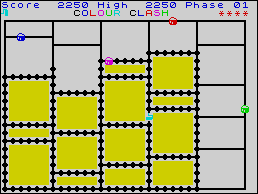
THE AUTHORS of Colour Clash seek to persuade the players that the world has been invaded by alien paint pots and that it can be saved only by colouring in all the rectangles on your television screen with a magic paintbrush. Why that should save the world, or why the world is threatened by those rather unintelligent pots is not explained, but the player is left to surround the rectangles and avoid the pots with only a few grenades to stave off destruction.
The idea behind Colour Clash is far from original but it is an enjoyable variation on the theme. Three keyboard options are presented and players with a Kempston or Sinclair joystick 1 can use them. Movement is, therefore, easy and the main problem is, as it should be, to avoid the paint pots and not to disentangle fingers or to stumble round lining up the brush to the exact pixel to make turns possible. There are four levels to the game, which are played in sequence and then repeated, becoming more and more difficult, so that the game provides a challenge both for beginners and advanced players.
Produced by Romik Software Ltd, Berkshire, for any Spectrum.
| COLOUR CLASH | Memory: 16K | Price: £7.99 | Joystick: Kempston, Sinclair | Gilbert Factor: 4 |
ALLANSON COMPUTING has produced a tape which combines all the thrills and excitement of real County Cricket. In this 48K game you play the part of the captain of the team of your choice. By making the correct decisions you can guide it to the top of the league in a series of 20-overs matches. In addition, you can sit back and watch the play in hi-res graphics, a kind of arcade management game.
You start by picking your team from 15 possible players according to their form and then decide the order of play. After the coin has been tossed the game begins. If you are put in to bat you then have to sit and watch your team play and hope you have made the correct decision. If you become impatient you can either jump to a later point in the match or SAVE it for later.
Once you are all out you have to choose the order of bowlers, each of which is limited to four overs. As the game is played you can also move the fielders round or, as before, jump. If you win a match you are presented with a cup and move to the next round.
Written almost entirely in Basic, the game is a fairly good reproduction of the original, including being fairly slow-moving.
| COUNTY CRICKET | Memory: 48K | Price: £4.95 | Gilbert Factor: 6 |
CONTINUING its attraction for graphics adventures, Carnell Software produced The Crypt for the 48K Spectrum. The game is like The Black Crystal, although the scenario is a series of underground crypts which contain various treasures and monsters.
Unfortunately, for an animated game in which the players move around the screen, it is very slow. The slowness creates difficulty during play and after you have been through two crypts, picking up a sword or fighting a monster, you could become disenchanted with the package. Alternatively, a monster could zap you before you get anywhere and you would have to start the game again.
If the threat from the monsters is not sufficient you will also have to contend with the poison which the monsters may exude; if you are really unfortunate you will meet the dark cyclops.
The Crypt should be a fascinating and entertaining game but its slowness and the ease with which you can die detracts from its appeal.
| THE CRYPT | Memory: 48K | Price: £4.95 | Gilbert Factor: 6 |
ANIMATED graphics are making an appearance in more and more computer games, giving them a realism which would not have seemed possible a few years ago. Death Chase uses animated graphics to simulate the view from a motor-cycle. The player moves on it through trees, chasing other riders and occasionally spotting tanks or helicopters. Speed and direction are both realistically simulated, so much so that the inevitable crash comes as a worrying shock.
Other riders cross the player's field of vision, weaving back and forth, but never out of sight for long. It is impossible to overtake those riders; they cannot fire at you, they cannot escape unless you crash. It is at those harmless, realistically-drawn characters that the player must shoot to kill. No longer is it angular-looking invaders which are being killed. They are convincingly-drawn humans who must be killed just as ruthlessly and just as pointlessly. Their deaths are neat; no mangled remains are shown to trouble the player's conscience. The player is practically immortal, with three lives per game, and an indefinite number of games to be played.
After shooting a few riders it is tempting to dismount and talk to them. Of course that it is not possible - this is an if-it-moves-shoot-it type game, not an adventure. Still, it is to be hoped that there will be a time when realism does not consist solely of creating more convincing victims, but in creating an environment where players face the consequences of their actions and killing people is not the only option.
Death Chase is produced by Micromega, London.
| DEATH CHASE | Memory: 16K | Price: £6.95 | Joystick: Kempston | Gilbert Factor: 6 |
DE-FUSION, for the 48K Spectrum, has Happy Larry as a bomb disposal expert. His mission, should he choose to accept it, is to defuse a never-ending supply of time bombs while collecting flags and avoiding the skinhead's boot and the demon skulls.
The game starts with the screen being covered by square stepping-stones, on to some of which are added the flags and skulls. Larry must then reach the time bomb without getting caught. To make life more difficult, every time he stands on a stepping-stone it sinks without trace. His only method of restoring them is to scroll the line he is on left and right; that brings in fresh stones from the edge of the screen.
He has one advantage over the boot - he can disappear off the edge of the screen and appear on the other side, leaving the boot trapped.
What appears to be a simple game can easily become very difficult, requiring plenty of thought, and all the time the seconds are ticking away. The game can be obtained from Lyndenhurst, London.
| DE-FUSION | Memory: 48K | Price: £5.95 | Joystick: Kempston | Gilbert Factor: 6 |
ADVENTURE games tend to have certain things in common, points which the experienced adventurer takes for granted. N, S, E and W usually move a character north, south, east and west respectively; commands take the form verb, noun. Once one adventure game has been played, those points become self-evident, but they are baffling for a beginner, and Demon Lord makes no provision for a beginner.
The game is recorded in two 48K parts on two cassettes, which are sold separately. The player's task is to find and rescue King Arthur from Perilous Castle and to kill the Demon Lord who has taken him prisoner.
Each location through which the player passes is drawn painstakingly in such detail that a scene containing a key will be re-drawn without it following the command TAKE KEY. That makes progress slower than it might be, while adding little to the game. In fact, as the game progresses and more and more commands are rejected as being NOT ACCEPTABLE, it becomes obvious that too much memory has been allocated to the graphics and not sufficient to vocabulary.
To be enjoyable, an adventure game should have a number of responses. Demon Lord repeatedly produces the response SORRY NOT ACCEPTABLE. That can produce the wrong impression. TAKE THE BLUE KEY is labelled as unacceptable, whereas other names would indicate by a formula such as TAKE WHAT? that the problem lay with the limited program vocabulary.
Demon Lord is produced by MCE, Mansfield.
| DEMON LORD | Memory: 48K | Price: £5.50 | Gilbert Factor: 5 |
STEP RIGHT into a nightmare with The Devil Rides In for the 16K Spectrum. You must stand alone in your magic circle and brandish your talisman against the various hosts of evil which are ready to destroy you.
Screen one of the game features ghosts and from there you will encounter spiders, little devils, winged demons, skeletons and the Angel of Death. Not only have you to deal with those horrors which cannot get into your protective circle but you also have to dodge the astral lights which can. Contact with the lights or with the boundary of the circle will destroy one of your three lives.
The game is obviously based on the Dennis Wheatley classic The Devil Rides Out and is complete with Angel of Death. It is an original twist to the Space Invaders type of program.
The graphics are good but slow and various pieces of demon and astral light are frequently left on the screen, producing an untidy effect. If you like games which are different from the usual adventure or zap 'em formats you will like this one from Carnell Software.
| THE DEVIL RIDES IN | Memory: 16K | Price: £5.95 | Joystick: Protek, AGF with Interface II | Gilbert Factor: 7 |
0NE OF SEVERAL programs from Keysoft for the home and office is The Dietician for the 48K Spectrum. It claims to be designed scientifically to help you lose weight at your own pace and on the diet of your choice.
The first step in using the program is to enter personal details such as your age, height, sex and activity level. You will be told what your ideal weight should be and you then have several options. The program will calculate how many calories you are allowed on the basis of how many weeks you wish to diet, or vice versa, and what your weight will be at weekly intervals if you stay with your calorie allowance. It will also indicate how many units of various food groups you can eat to shed the requisite amount of pounds - or kilograms, for that matter, as you can choose to operate in either metric or Imperial measure.
If you prefer to keep a computerised record of your diet, rather than written notes, and like to have simple calculations performed for you, you might find the program useful. Otherwise, it appears to have several shortcomings. Unless you already know something about dieting and calorific values, you may be deterred by the program's estimation of what is an ideal weight, which seems to take more account of fashion than common sense.
The various diet plans, too, are over-simplified and it is no easy matter to discover from the program how many ounces or Grammies of each particular food your diet allows. It is also easy to get lost in the program, which does not always offer a simple route back to the main menu - if you will forgive the expression.
The Dietician is available from Keysoft, London.
| THE DIETICIAN | Memory: 48K | Price: £6.95 | Gilbert Factor: 4 |
DLAN, short for display language, is a system for generating textual displays for both versions of the Spectrum. By defining any number of windows on the screen you can define the text, type style, INK and PAPER colours and direction of scroll in it. You can also define a pattern round the edge of the window. All the features can be put together to produce an advertising display, at far less cost than a purpose-built system.
Each command is written as a REM statement, followed by a number of parameters detailing what will happen on-screen. Once complete, one USER command will set the whole thing running and it will then cycle around the commands non-stop. As with any new language, time must be spent learning it but effective results can be obtained by non-computer users in a short time. As well as all the commands to define the parameters it is also possible to build-in subroutines so that one display can call others.
What sets it apart from an ordinary program is the choice of 11 typefaces, four in the 16K version. They add a touch of professionalism to the display. A good utility program which can only add to the uses to which a Spectrum can be put. It can be obtained from Campbell Systems.
| DLAN | Memory: 16K | Price: £7.95 | Gilbert Factor: 7 |
DUNGEONS OF DOOM also includes the game Escape from the Underworld. The first involves the player descending through a maze to find treasure; the second involves climbing upwards to escape the dungeons.
In each game a section of the maze is shown on the screen. Players who were attracted to the game by its bright, prismatic cover will be disappointed by its graphics. The maze comprises squares and rectangles and the monsters which inhabit it are not displayed, or even described, but merely named - the effect is of a ZX-81 game converted quickly for a Spectrum.
Maze generation in the program is faulty and it is possible to materialise in a section from which there is no exit. If that section is small the flaw soon becomes obvious but on a bigger scale a player could move pointlessly for some time without realising escape was impossible.
The game is slow-moving; despite the poor graphics the picture appears slowly and the player is required to press ENTER after every move. The speed is explained by the game being written in Basic but the need to press ENTER and the sloppy maze generation are programming flaws.
Dungeons of Doom is produced for the 48K Spectrum by Temptation Software Ltd, Sussex.
| DUNGEONS OF DOOM | Memory: 48K | Price: £5.95 | Gilbert Factor: 3 |
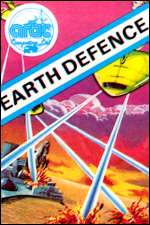
EARTH DEFENCE, for the 16K Spectrum, is a fairly faithful reproduction of the arcade game Missile Defence. In it you must defend your cities and missile sites from invading nuclear missiles and other craft.
You have three missile batteries from which to fire and a controllable cross-hair sight. Timing is all-important. You have a limited number of missiles and time must be allowed for them to reach their destination. If you survive the first wave of attackers your score is totalled according to how many cities and missiles you have remaining and another wave appears. Bonus cities are given every 1,000 points. The game has three levels of skill and can be played by one or two players, there is also provision to use either a Sinclair or Kempston joystick or the keyboard.
The graphics are adequate for this kind of game, although the sound is rather limited during the explosions.
| EARTH DEFENCE | Memory: 16K | Price: £4.95 | Joystick: Sinclair, Kempston | Gilbert Factor: 5 |
MANY PROGRAMMERS would say that there is not much you could do to make Sinclair Software better, apart from making it faster, but Extended Basic for any Spectrum has proved them wrong. The extensions are more like toolkit routines and most of them are for use outside Basic programs.
There are 10 commands available in the package and they include auto line numbering, renumbering, memory left and the variables being used in a program. The program will also allow errors in Basic listings to be tracked using a TRACE command.
A real-time clock is also included in the package and it can be switched on to and off the screen at any time. It can also be used in other Basic programs and will continue to operate while the computer is doing other things.
The commands are entered as keywords, just as are those of Sinclair Basic, with the push of only two keys. That makes usage easy and provides a compatibility of use with the rest of the Basic on the Spectrum.
The package is called Extended Basic but the commands which are included form what could more correctly be described as a toolkit rather than an extension to a language.
The utilities, however, are useful in writing long programs and can increase the efficiency of the machine.
Extended Basic can be obtained from CP Software, Bucks.
| EXTENDED BASIC | Memory: 16K | Price: £9.95 | Gilbert Factor: 7 |
ALL THE ADVERTISING for Fighter Pilot has been a comparison between it and the well-known Flight Simulation from Psion. While they are similar they each appear to be aimed at different sectors of the buying public. Each succeeds in its own area. To do everything it does Fighter Pilot may not teach you so much about controlling an aircraft but it is just as entertaining. If possible buy both; if not, Fighter Pilot seems to have the edge.
On loading the game you are given four options - landing practice, flying training, air-to-air combat practice and air-to-air combat. To those you can add blind flying, where you lose the horizon, and/or cross winds and turbulence. Having made your choice you are switched to the cockpit, where all the usual controls are visible, including artificial horizon.
If needed, a map can be called-up showing the positions of the four runways and the various beacons - also any enemy aircraft if in combat mode. The map is updated while you watch it.
The flying area has wraparound so you cannot fly too far - about 100 x 150 miles - but it can give odd instrument readings when flying over a border. The game is compatible with Kempston, Sinclair and AGF joysticks and the cursor keys. It can be obtained from Digital Integration.
| FIGHTER PILOT | Memory: 48K | Price: £7.95 | Joystick: Kempston, AGF, Sinclair | Gilbert Factor: 8 |
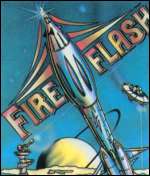
ALIEN MISSILES are descending towards the planet's surface, showering warheads on buildings and silos, while planet-levelling bombs detonate above the ground, preparing the way for the landing of the enormous alien mothership. Thus the scene is set for Fireflash, a run-of-the-mill arcade game from Abacus Programs which owes not a little to the popular Missile Command. You are in control of the Fireflash guided missiles and laser cannons which comprise the planet's defence.
Visually the game is more or less what you would expect and the onscreen action holds few surprises, but the machine code program is sufficiently competent to while away an idle hour or two, and there is a poke facility allowing you to alter some of the program features.
On the flip side is Destroyer, a plodding submarine attack simulation which employs the limited sound effects of the Spectrum to imitate your destroyer's sonar.
| FIREFLASH | Memory: 16K | Price: £5.95 | Gilbert Factor: 5 |
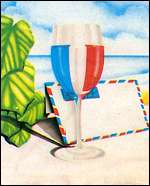
THE CASSETTE insert for French is Fun claims that the program is designed for the student and the traveller, which reveals a basic flaw, since a less convenient and portable form of phrasebook could hardly be devised. Nevertheless, it is clear that a fair amount of thought and care have gone into the program. Attractive graphics accompany each of the various themes you can study, such as countryside, beach, cafe or street, and you can choose the method you want to use. In the picture-only mode, the French name for each element is given as it unfolds; there is also a picture and phrases mode, or pictures with a French-English or English-French test.
The test consists of filling in the word required, with the computer accepting only the letters it is expecting. Unfortunately, the computer's spelling of French is not entirely reliable and some of the words in its vocabulary are unusual, to say the least. These are faults in what might otherwise have been an entertaining and instructive program.
French is Fun is produced by CDS Micro Systems, Doncaster.
| FRENCH IS FUN | Memory: 48K | Price: £5.95 | Gilbert Factor: 5 |
THE GALACTIC attack force is, apparently, attacking the earth. It is the player's job to save our planet for as long as possible by destroying the downward-moving galactic troopers, their landing craft and mothership, as frequently as possible.
This description sounds familiar and, indeed, the game and its object would be instantly recognisable to anybody who had played Space Invaders or one of its many other imitators. Move left, move right, fire. See the explosion. Hear the beeping noises. All that was entertaining and original, five years ago. A new variation seems pointless and dated. In writing Galactic Trooper the authors proved they can produce good imitations. Such a game is a test only of their programming skill, not an addition to the range of the software market.
Galactic Trooper is produced by Romik Software Ltd, Berkshire.
| GALACTIC TROOPER | Memory: 16K | Price: £5.99 | Joystick: Kempston | Gilbert Factor: 3 |